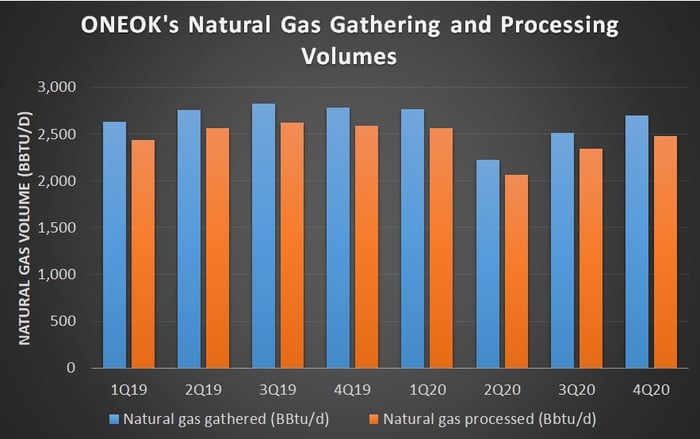Pipeline operator ONEOK (OKE -1.51%) is trading at a high dividend yield close to 8%. Though the stock's yield has fallen significantly from around 15% that it was sporting six months back, it is still extremely attractive. Why is ONEOK stock's yield high and what can we expect from it in the future? Let's find out next.
ONEOK's gathering and processing earnings are a bit volatile
ONEOK stock fell steeply last year. The company's earnings got impacted by the demand destruction resulting from the coronavirus. ONEOK's gas gathering and processing operations are the most exposed to fluctuations in demand and commodity prices. Another area where ONEOK's earnings are exposed to commodity prices is its optimization and marketing activity, where the company seeks to earn income by exploiting location or product price differentials.
Lower oil and gas production impacted ONEOK's gas gathering and processing volumes and its earnings in 2020.

Data source: ONEOK. Chart by author.
As the above graph shows, the volumes are recovering, though they remain lower than in 2019. ONEOK expects its natural gas gathering volumes to range 2,475 BBtu/d (Billion British thermal units per day) to 2,830 BBtu/d this year. At the mid-point, this implies a growth of 4% over 2020 volumes. Similarly, it expects its gathering volumes to grow 7% in 2021.
The good thing is that ONEOK's other segments more than made up the fall in its gathering and processing earnings last year. That helped the company post higher earnings for the year, despite the impacts of the pandemic.
ONEOK's earnings are largely fee-based
ONEOK's adjusted EBITDA rose 6% last year. More than 90% of the company's 2020 earnings were fee-based. Higher natural gas liquids volumes and higher gas transport volumes drove this growth. ONEOK's NGL and natural gas transport operations make the company's earnings resilient during challenging market environments. At the same time, its vertically integrated operations right from gas gathering to gas and NGLs marketing allow it to generate higher earnings when environment is favorable.
OKE Dividend data by YCharts
As the graph above shows, such integrated midstream operations and strategically located assets allowed ONEOK to grow its dividends faster than its midstream peers.
OKE Total Return Price data by YCharts
That also explains ONEOK's higher total returns in the last ten years.
ONEOK's debt has risen
ONEOK's long-term debt rose from $12.5 billion in 2019 to $14.2 billion at the end of 2020. Higher interest expense partly contributed to a fall in ONEOK's 2020 distributable cash flow, even though its EBITDA for the year was higher than in 2019.
Still, the company's net debt to EBITDA ratio improved from 4.8 at the end of 2019 to 4.6 at the end of last year, due to higher EBITDA. ONEOK targets a net debt to EBITDA ratio below 4 in the long run. It intends to pay down debt using any additional cash that it generates.

Image source: Getty Images.
Additionally, the company plans to cut down its capital expenditures by 70% in 2021 to conserve cash. ONEOK's distributable cash flow last year covered its dividend payments by 1.2 times. All in all, the company's higher debt isn't too concerning right now.
An attractive buy
ONEOK expects increased producer activity this year. That coupled with its recently completed projects should help a roughly 12% increase in its EBITDA for the year. If the demand and commodity prices don't fall to last year's levels, ONEOK looks well-positioned to meet its expectations.
ONEOK's fee-based earnings, its vertically integrated and strategically located assets, and its capital projects should allow it to continue generating peer-leading growth in the long-term. Overall, not only does the stock's yield looks on a sustainable footing but the company looks poised for long-term growth as well.







